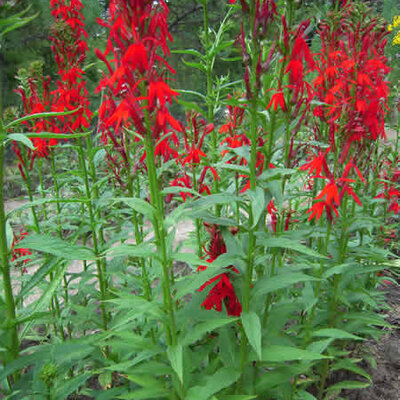
Lobelia cardinalis
This hardy perennial can reach 1.20 m in height. It has slender, upright stems bearing clusters of tubular, red flowers. This decorative plant is often found in water gardens.
What are the characteristics of the Lobelia cardinalis plant?
Lobelia cardinalis is a hardy perennial native to North America. It grows along watercourses and floodplains from Canada to Colombia. It is a favorite with bees, butterflies and hummingbirds. Its name refers to cardinal red, a deep, scarlet-like color reminiscent of the robes of the Catholic Church. This 1.20 m-high plant produces clusters of red flowers. Underneath, its lanceolate leaves turn green or purple.
Like the greater lobelia, Lobelia siphilitica, cardinal lobelia grows in deep, cool, moist soil. It is often planted beside a freshwater pond or in a colorful garden, alongside yellow-tinged grasses or a pseudo-cereal such as Oro de Valle quinoa. This decorative plant, chosen to compose pretty bouquets of flowers, also holds up well in the vase.
How to plant Lobelia cardinalis?
Lobelia cardinalis should be sown either in spring, from February to March, or in autumn, from October to November, in pots or trays under a light shelter.
For spring sowing, place seeds in a damp substrate in the fridge for 60 days to lift dormancy. Monitor regularly and place in a bucket if germination begins, taking care not to cover the seeds too much, as this species prefers to germinate in the light.
For autumn sowing, sow lightly in seed trays. Cover lightly with fine soil and leave the plants outdoors throughout the winter.
Choose a semi-shaded position and moist soil for these plants, if possible beside a freshwater pond or river.
How to use Lobelia cardinalis?
Lobelia cardinalis is harvested from June to October. Decorative and hardy, this plant not only beautifies gardens, but is also renowned for its antispasmodic properties in the treatment of asthma. Ancient Amerindian peoples used the roots and leaves in infusions or poultices for typhoid fever, syphilis, headaches, intestinal worms, rheumatism, colds, fevers, digestive problems, nosebleeds, croup, pains, chancres, menstrual disorders and wounds.
Cardinal lobelia also contains alkaloids such as lobeline and lobelanin, so it should be used with care.
These products may also be of interest to you
in bucket
For spring sowing, place seeds in a damp substrate in the fridge for 60 days to lift dormancy. Monitor regularly and place in pots if germination begins, taking care not to cover the seeds too much, as this species prefers to germinate in the light. For autumn sowing, sow lightly in trays. Cover lightly with fine soil and leave outdoors throughout the winter.
Do well in sunny, cool, well-drained soil.
March, April, May, September, October
June, July, August, September, October
in the ground, in pot
semi-shade, sunny
fort
humus
wet, drained, fees
Lobelia cardinalis
mid-season
300 seeds
Red
From 100 to 120 cm
elongated
North America
It is mainly known for its antispasmodic properties in the treatment of asthma. It is the roots, leaves or seeds that are used for various pathologies. [Medicinal Plants of the Mountain West, Michael Moore]. It also contains the alkaloid lobeline. It was used by the Cherokee, Iroquois, Crow, Meskwaki, Pawnee, Delaware, Jemez and Zuni peoples as an analgesic and to treat fevers, rheumatism, intestinal parasites, colds, venereal diseases and pulmonary problems. [Native American Ethnobotany, Daniel Moerman.]






